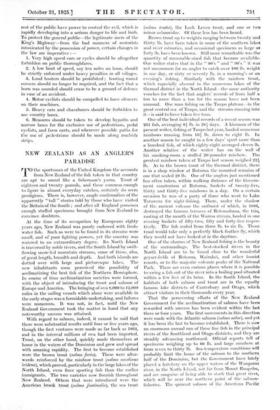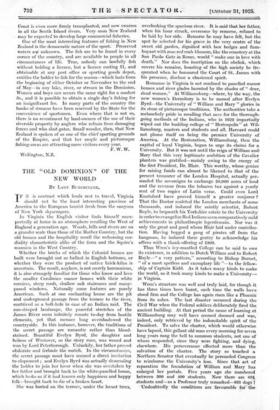NEW ZEALAND AS AN ANGLER'S PARADISE
TO the sportsman of the United Kingdom the accounts from New Zealand of the fish taken in that country arc apt to sound like a fisherman's yarns. Trout of eighteen and twenty pounds, and these common enough to figure in almost everyday catches, certainly do seem prodigious. There is, however, ample confirmation of the apparently "tall " stories told by those who have visited the Britain of the South ; and after all England possesses enough stuffed specimens brought from New Zealand to convince doubters.
At the time of its occupation by Europeans eighty years ago, New Zealand was poorly endowed with fresh- water fish. Such as were to be found in its streams were small, and of poor fighting powers, yet the country was watered to an extraordinary degree. Its North Island is traversed by noble rivers, and the South Island by swift- flowing snow-fed mountain streams, some of these, also, of great length, breadth and depth. And both islands are dotted over with large and picturesque lakes. The new inhabitants soon perceived the possibility of acclimatizing the best fish of the Northern Hemisphere. In course of time acclimatization societies were formed, with the object of introducing the trout and salmon of Europe and America. The bringing of ova 8,000 to 12,000 miles in the sailing vessels which alone were available in the early stages was a formidable undertaking, and failures were numerous. It was not, in fact, until the New Zealand Government took the matter in hand that any noteworthy success was attained.
With regard to salmon, indeed, it cannot be said that there were substantial results until four or five years ago, though the first ventures were made as far back as 1864, and in the interval millions of ova had been imported. Trout, on the other hand, quickly made themselves at homein the waters of the Dominion and grew and spread with amazing. rapidity.. The first to become established were the brown trout (salmo fario). These were after- wards reinforced by the rainbow trout (saint° savelinus iriden.$), which proved, particularly in the large lakes of the north Island, even finer sporting fish than the earlier - immigrants. The two varieties now flourish throughout New Zealand. Others that were introduced were the American brook trout (salmo fontinalis), the sea trout (salmo trutta), the Loch Leven trout, and one or two minor salnionidae. Of these less has been heard.
Brown trout up to weights ranging between twenty and thirty lb. have been taken in some of the southern lakes and river estuaries, and occasional specimens as large as forty lb. have been known. Still more remarkable was the quantity of reasonable-sized fish that became available-, One writer states that in the " 80's " and " 90's " it was not uncommon for an angler to catch over 100 lb. weight in one day, or sixty or seventy lb. in a morning's or an evening's fishing. Similarly with the rainbow trout, which especially abound in the numerous lakes of the thermal district in the North Island—the same authority vouches for the fact that anglers' records of from half a ton to more than a ton for the season have not been unusual. One man fishing on the Taupo plateau—in the great central sea of Taupo, and the streams running into it—is said to have taken five tons.
One of the best individual records of a recent season was 261 fish, averaging 8i lb. in 281 days. A kinsman of the present writer, fishing at Taupo last year, landed numerous rainbows running from 161 lb. down to eight lb. In another season he caught in a few days' sport more than a hundred fish, of which eighty-eight averaged eleven lb. Another relative of the writer has on the wall of his smoking-room a stuffed 20-pounder rainbow. The greatest rainbow taken at Taupo last season weighed 24 lb. As to the brown trout of the thermal district, there is in a shop window at Rotorua the mounted remains of one that scaled 28 lb. One of the anglers just mentioned has often taken, within walking distance of the Govern- ment sanatorium at Rotorua, baskets of twenty-five, thirty and thirty-five rainbows in a day. On a certain occasion he was of a party of three who went to Lake Tarawera for night-fishing. There, under the shadow of the ancient volcano the outburst of which, in 1886, destroyed the famous terraces of Rotomahana, the trio, casting at the mouth of the Wairoa stream, landed in one evening baskets of fifty-two, fifty and forty-five respec- tively. The fish scaled from three lb. to six lb. Those trout would take only a perfectly black feather fly, which they would not have looked at in the daytime.
One of the charms of New Zealand fishing is the beauty of the surroundings. The best-stocked rivers in the North Island are to be found close to the wonderful geyser-fields of Rotorua, Wairakei, and other tourist resorts, or to the majestic volcanic peaks of the National Park. There are even curious places where it is possible to swing a fish out of the river into a boiling pool situated within a few feet of its brim. In the South Island, the habitats of both salmon and trout are in the equally famous lake districts of Canterbury and Otago, which attract visitors in their thousands every year.
That the persevering efforts of the New Zealand Government for the acclimatization of salmon have been rewarded with success has been evident within the last three or four years. The first movements in this direction were made with the Atlantic salmon (salmo salar), and yet it has been the last to become established. There is now an enormous annual run of these fine fish in the principal rivers of the Southland and Otago districts, and they are steadily advancing northward. Official reports tell of specimens weighing up to 60 lb. and large numbers at from seven to thirty lb. Sea-temperature conditions will probably limit the home of the salmon to the southern half of the Dominion, but the Government have lately placed a hatchery on the upper waters of the Wanganui river, in the North Island, not far from Mount Ruapehu, and are sanguine of being able to stock that great river, which will be near the northern point of the salmon- fisheries. The quinnat salmon of the American Pacific • Coast is et'en more firmly transplanted, and now swarms in all the South Island rivers. Very soon New Zealand may be expecte-2 to develop large commercial fisheries.
One of the most interesting features of fishing in New Zealand is the democratic nature of the sport. Preserved waters arp unknown. The fish are to be found in every corner of the country, and arc available to people in all circumstances of life. True, nobody can lawfully fish without holding a licence, but a licence costing £1, and obtainable at any post office or sporting goods depot, entitles the holder to fish for the season—which lasts from the beginning of either October or November to the end of May—in any lake, river, or stream in the Dominion. Women and boys can secure the same right for a modest 5s., and it is possible to obtain a single day's fishing for an insignificant fee. In many parts of the country the banks of streams have been reserved by the State for the convenience of sportsmen. Even where that is not so, there is no resentment by land-owners of the use of their riverside property by anglers who refrain from damaging fences and who shit gates. Small wonder, then, that New Zealand is spoken of as one of the chief sporting grounds of the Empire, and that her ample and picturesque fishing-areas are attracting more visitors every year.































































 Previous page
Previous page